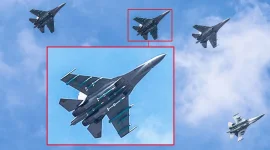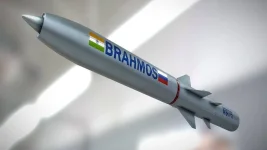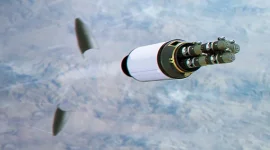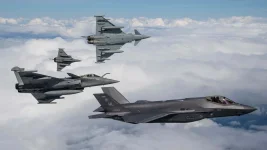- Views: 4K
- Replies: 2
Amidst the complex security dynamics of South Asia, India and Pakistan continuously upgrade their air defence capabilities as a core part of their national security and deterrence strategies.
A recent comparison, highlighted by defence analysts, reveals significant differences in the sophistication, range, and technological capabilities of the air defence networks maintained by the two nations.
India employs a comprehensive, multi-layered system, while Pakistan operates a more limited, though developing, network.
India's Integrated Air Defence Shield
India has established a robust, tiered air defence network designed to intercept a wide array of aerial threats, ranging from enemy fighter aircraft and drones to cruise and ballistic missiles. This strategy addresses security challenges emanating from both Pakistan and China. Key components include:- S-400 Triumf: Acquired from Russia, the S-400 system represents the apex of India's air defence. With deliveries commencing in 2021, this long-range system boasts an impressive reach of 400 kilometres. Its advanced multi-function radar (often featuring Active Electronically Scanned Array - AESA technology) can track numerous targets simultaneously and engage high-speed threats, including aircraft and missiles travelling at hypersonic speeds (up to Mach 14). Deployment along borders significantly enhances India's ability to neutralize aerial threats deep within adversary airspace.
- Barak-8 (MR-SAM/LR-SAM):A successful joint venture between India and Israel, the Barak-8 system provides medium-to-long-range defence for the Indian Air Force and Navy. Capable of engaging targets between 70 and 100 kilometres away, it utilizes advanced AESA radar technology (EL/M-2084) for 360-degree protection against aircraft and missiles, including subsonic cruise missiles like Pakistan's Babur.
- Akash System: Developed domestically under the "Make in India" initiative, the Akash system offers crucial medium-range air defence. The original Mk1 variant covers up to 30 kilometres, while the Akash-Next Generation (NG) extends this reach to 70 kilometres, engaging targets at speeds up to Mach 2.5 using its indigenous Rajendra III AESA radar. Its widespread deployment provides cost-effective defence against fighter aircraft.
- SPYDER:This Israeli-origin system provides short-range protection (15-35 km), utilising a combination of Python-5 and Derby missiles. Its flexible targeting system, using both electro-optical and radar guidance, makes it effective against low-flying aircraft and drones.
- QRSAM: Another indigenous system developed by India's Defence Research and Development Organisation (DRDO), the Quick Reaction Surface-to-Air Missile provides mobile, short-range defence (25-30 km). Its AESA radar offers 360-degree coverage, designed for rapid response against agile aerial threats near forward operating areas.
- SRSAM: Primarily deployed on naval vessels like the aircraft carrier INS Vikrant, this short-range system (25 km) uses AESA radar to protect maritime assets from close-in air attacks.
Pakistan's Air Defence Capabilities
Pakistan continues to modernize its air defence network, primarily focused on countering India's air power. Its inventory relies significantly on systems sourced from China:
- HQ-9P/BE: This Chinese system is Pakistan's primary long-range air defence solution, with reported ranges between 100 and 200 kilometres. It can engage high-speed targets (up to Mach 14), posing a threat to modern fighter jets. However, its phased array radar technology is generally considered less advanced than the AESA systems used in India's S-400 and Barak-8. Deployments are reportedly concentrated around vital strategic locations.
- LY-80 (HQ-16): Also of Chinese origin, the LY-80 provides medium-range coverage (40-70 km) against targets up to Mach 2.5. While capable against conventional aircraft and subsonic missiles, it faces limitations against faster threats like India's supersonic BrahMos missile. Newer variants offer improvements but may lack the all-around coverage of comparable Indian systems.
- FM-90: This short-range Chinese system has a reach of about 15 kilometres and can engage targets flying up to Mach 1.2. Its effectiveness is limited against faster aircraft and standoff weapons employed by India.
- Crotale: A French-origin, command-guided system acquired earlier, the Crotale is effective against older threat profiles but is technologically dated compared to modern radar-guided systems.
- MPQ-64 Sentinel: This US-supplied radar enhances Pakistan's target detection capabilities but doesn't offer the same level of integration or range as India's primary air defence radars.
Comparative Edge: Range, Technology, and Strategy
A direct comparison underscores India's significant advantages:- Range Dominance: The S-400's 400 km range far exceeds the HQ-9's 100-200 km reach, allowing India potential engagement capability over substantial parts of Pakistani airspace.
- Technological Superiority: India's widespread use of advanced AESA radars provides superior detection, tracking, and jamming resistance compared to the predominantly phased array and older technologies used in Pakistan's systems.
- Engagement Capability: Indian systems like Barak-8 and Akash-NG are better equipped to handle high-speed threats (Mach 2.5-3+) compared to Pakistan's medium-range LY-80. The S-400 further enhances capability against hypersonic threats.
- Strategic Depth: India's multi-layered approach creates redundancy and resilience, vital for managing potential threats on multiple fronts. Pakistan's system appears more focused on point-defence of critical assets.
This integrated shield enhances India's ability to deter and defend against aerial incursions, potentially dominating crucial airspace in a conflict scenario and neutralizing key Pakistani aerial threats.
While Pakistan is modernizing its defences with systems like the HQ-9, it currently lags behind in terms of range, radar technology, and overall network integration, facing challenges against India's advanced standoff weaponry and high-speed missiles.
The continued development of indigenous systems also strengthens India's self-reliance in the critical domain of air defence.





